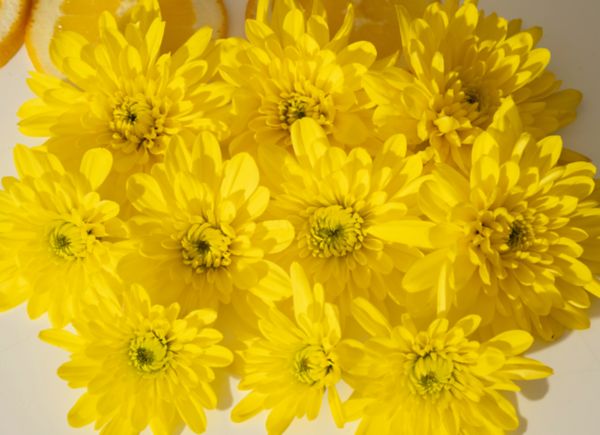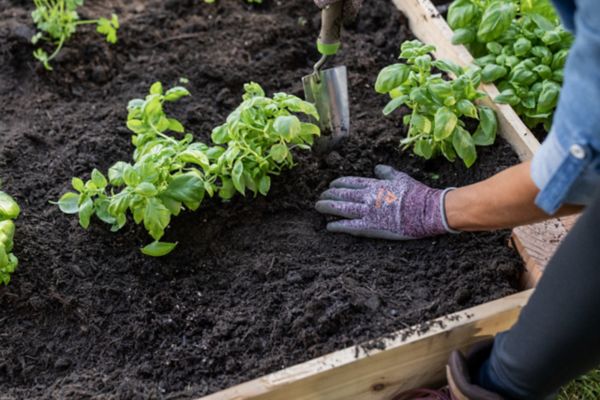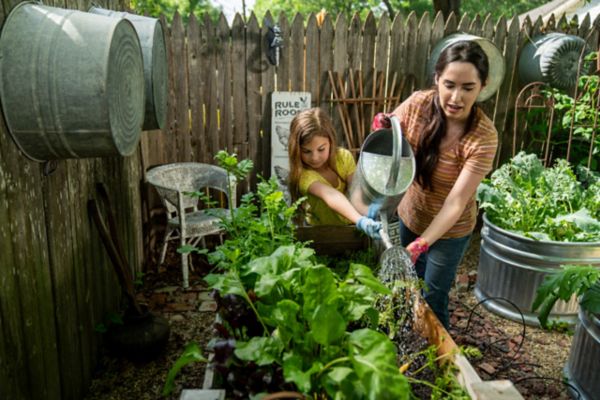How to Grow Hibiscus
Authored by Leah Chester-Davis
Hibiscus shows off in gardens with arguably the most flamboyant blooms in any landscape.
Hardy hibiscus is a perennial shrub that will die back in winter and return in the spring. Sometimes called dinner plate hibiscus because the size of its blooms can be 8 to 10 inches, the plant is large and in charge in any setting. It can grow 3 to 7 feet tall with a spread of 2 to 4 feet. Dwarf varieties are available.
This plant is a vigorous grower that has a rounded, shrub-like appearance. It thrives in its native environment which is along marshes, stream banks, and wetland areas. Today, numerous Hardy Hibiscus hybrids are available. The individual flowers only last a day or two, but the plant puts out many new flowers in rapid succession. It typically blooms from late June to September. Few other plants shout “Summer!” like the Hardy Hibiscus. Its bold, colorful blooms have a tropical appearance and are often pink, bright red, white, and bicolor. The foliage varies from green to bronze to deep purple to almost black.
Hibiscus is in the same family of plants that includes okra, cotton, and hollyhocks. Look closely at the blooms and you will see similarities, though the size differs. Hummingbirds and other pollinators are attracted to the vibrant blooms. Hibiscus can be used in many ways in the landscape. It can highlight patios, be grown in containers, add interest, structure, and color to borders, or be used as screens or hedges.
About hardy hibiscus
| Botanical name: | Hibiscus moscheutos, Hibiscus laevis; many hybrids are from these and other Hibiscus species that are native to eastern U.S. |
| Common name: | Hardy hibiscus, sometimes called swamp or rose mallow |
| Plant type: | Herbaceous perennial |
| Size: | 3 to 7 feet tall and 2 to 4 feet wide |
| Sun exposure: | Full sun |
| Soil type: | Average or medium to wet |
| Soil pH: | 6 to 7 pH |
| Hardiness zones: | 5 to 9 |
| Average first frost: | Varies by region |
| Average last frost: | Varies by region |
| Container friendly: | Yes, container must be large |
| Beginner friendly: | Yes |
Growing
Hardy hibiscus can be started from seed or plants can be purchased from your local garden center. To get a jump-start on the growing season, the National Garden Bureau recommends starting seeds indoors 6 to 12 weeks before the last frost date in your area. Soak the seeds overnight and then sow ½ inch deep into well-draining soil. Keep soil moist. After four to five weeks, transplant to larger pots. After the last frost date, begin hardening off the transplants by transferring outdoors to a shady spot for a few hours each day. When they have become acclimated to the outdoors, plant them in your landscape or position them on your patio. Giving them a chance to become acclimated helps prevent bud loss and minimize foliage loss.
If growing in a container, use a large container with drainage holes and a well-drained potting mix. Even though this plant likes water, its roots may rot in the container if it doesn’t drain adequately.
3 other types of hibiscus
According to the National Garden Bureau, some of the most popular series are Summer Spice, Luna, Head Over Heels, and Summerific. In addition to hardy hibiscus, there are a few other forms of hibiscus. Among them:
Shrub hibiscus
Shrub Hibiscus, which is commonly called Rose of Sharon (Hibiscus syriacus). Rose of Sharon is an old-fashioned, deciduous plant that has been grown in gardens for ages, but newer varieties make it a plant of interest for the landscape. It has a woody, upright habit, dark, glossy green leaves, and can grow quite tall, to about 12 feet, but dwarf varieties are available. It grows as a shrub form or can be pruned into a standard to form a small tree. It blooms from June to October with showy, hollyhock-like, 5-petaled flowers. The flowers are about 2 to 3 inches in diameter. Among the colors are white, pink, lavender, purple, and red. It grows in Zones 5 to 8 and is available in single or double flowers. ‘Azurri Blue Satin’ is a single blue form accented with magenta that is said to produce no seeds, a desirable feature for blue forms. ‘Pink Chiffon’ is an elegant double pink form. ‘Lil’ Kim’ is white with striking red eyes and is a dwarf form, growing to about 3 to 4 feet tall.
Tropical hibiscus
Tropical Hibiscus (Hibiscus rosa-sinensis) is more suited to warmer locations as it is not frost-tolerant. It is popular in containers on the patio and in cold climates can be overwintered indoors. It can grow 4 to 10 feet tall and 5 to 8 feet wide and thrives in full sun to part shade. It has dark, glossy green foliage and large flowers, about 4 to 8 inches in diameter, and is available in either single or double forms. It is winter hardy in Zones 9 to 11. It prefers temperatures above 50 degrees F. It also is popular as a houseplant. Tropical hibiscus likes full sun for best blooms but will tolerate light shade. Flowers are typically hues of reds, oranges, yellows, and reddish pink colors.
Red-leaved hibiscus
Red-leaved Hibiscus (Hibiscus acetosella) is prized more for its foliage than for its flowers. It has deep, red-purple foliage that resembles a Japanese maple and adds a stunning contrast to the varying shades of greens of many other plants. It grows quickly during the summer season. It has small, 2-inch flowers that are a deep pink to purple. Hardy in Zones 8 or 9, it is grown as an annual in other regions. There are several varieties available, and they are lovely in mixed borders or mixed with other large-leaved plants such as cannas for a tropical look.
Planting
Plant hardy hibiscus in full sun with plenty of room to allow for good air circulation. The plant is tolerant of a wide range of soils if they do not dry out. It does best in slightly acidic, well-draining soil that has been amended with plenty of organic matter. If in Northern climates, plant in full sun in your landscape. If you live in the South, Hibiscus may benefit with some slight shade, particularly from the hot afternoon soon.
Plant after the danger of frost has passed. Dig a hole that is double the size of the container. The crown of the plant should be at or slightly above the soil surface. Press the loose dirt around the plant and water in. Add more soil if the base of the plant shows after watering.
Keep the soil moist but not saturated. Do not allow it to dry out. Drought conditions stress the plant and may reduce its growth and blooms.
Hardy hibiscus, particularly the newer, more compact varieties, require little pruning during the growing season. If you have an older variety that grows quite tall, it can be cut back in the early spring. The Missouri Botanical Garden advises pinching back growing tips when they reach 8 inches and again at 12 inches if bushy plants are desired. If you miss this step, when the plant is 2 to 3 feet tall, cut it back by about one-third to one-half. This helps the plant have a more compact and attractive appearance. For Rose of Sharon (Hibiscus syriacus), prune it in the winter when it is dormant.
In the late fall or winter, leave the woody stems of hardy hibiscus standing until spring, then prune them back to 4 to 6 inches. New growth will emerge from the ground. In locations with harsh winters, mulch around and over the plant may help it survive.
Fertilizing
- Hibiscus plants are heavy feeders. Fertilize regularly throughout the growing season. Both organic and inorganic fertilizer for flowers and shrubs is available in liquid or granular formulas, and some are labeled specifically for Hibiscus. Follow label directions.
- For indoor plants, use one-half strength formulation about every month or so during the growing season, and less frequently in winter.
Controlling Pests, Diseases, and Other Problems
- Aphids, thrips, and spider mites sometimes bother this plant. Horticultural oil or insecticidal soap can be used; follow label directions.
Hibiscus are heavy feeders. Plan for regular feedings during the growing season.
Expert Tips
- Hardy hibiscus is one of the last perennials to emerge in the spring, sometimes as late as mid-June, so don’t get too concerned when it is slow to make its appearance. When the new shoots finally emerge, they take off and grow quickly.
- Hibiscus are water-tolerant and may be a good option for low, damp areas that stay moist, for areas near water features, or for rain gardens. They are dramatic and can be a beautiful accent plant, or to add interest to a perennial garden. When several are planted, they can serve as a hedge.
Frequently asked questions
What kind of maintenance is needed for my hardy hibiscus in the fall?
Spring is typically the best time to cut the flower stems back, according to the National Garden Bureau. Cut back the stems to about 6 inches. Over time, the clump will increase in size, resulting in a larger plant with more blooms.
What causes the stems to grow tall and be unable to support the large blooms?
Your plant likely needs to be in a location that receives more sun. Full sun is best. Shady areas can result in the stems growing too tall to support the large blooms. Shade can also affect bloom size and decrease the number of blooms.
Do I need to deadhead my hardy hibiscus?
Because blooms only last a day, deadheading can help keep the plant looking its best though it isn’t necessary for continued bloom.
Why might my hibiscus be losing its leaves and buds?
Check the water level; it sounds like the plant may be getting too dry. Hibiscus needs soil that remains moist and doesn’t dry out completely. Make sure the plant is in full sun as well.
Is it necessary to prune this plant?
No, though its growth and appearance can benefit from pinching it back in early summer as it starts to grow. Pinching back the growing tips when it is about 8 inches tall and again when it is 12 inches tall will encourage branching and more flower stalks.





